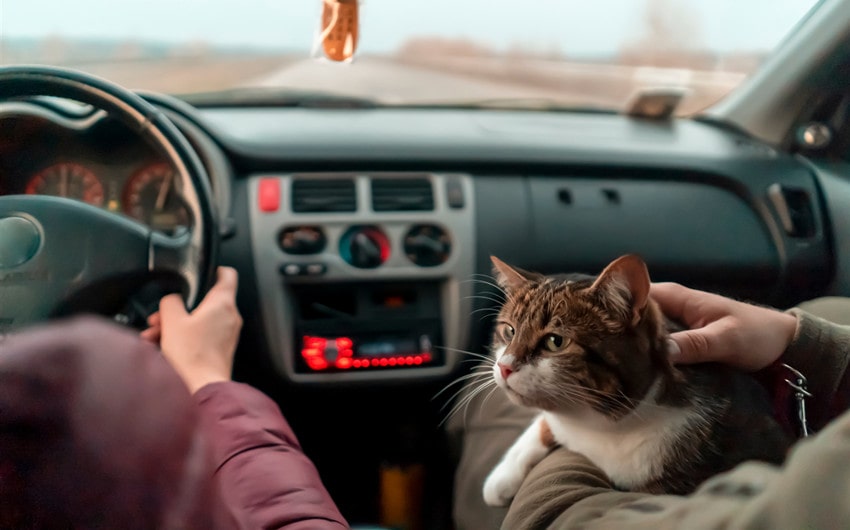Traveling With Cats in the Car: How to Keep Them Safe, Calm, and Comfortable
Traveling with a cat in the car can feel like packing a bundle of nerves in a box and asking it to stay quiet for hours. But it doesn’t have to be a battle of wills. With the right setup and a little empathy, you can turn the experience into something manageable — maybe even peaceful. Whether you’re driving to a new home, heading on a road trip, or just visiting family, here’s how to make the journey smoother for both of you.
Start With the Right Carrier
The carrier is your cat’s home base while on the move. Think of it like a hotel room on wheels — it needs to be safe, secure, and familiar. Choose a size that allows your cat to turn around and lie down comfortably. A too-small carrier adds stress. A too-large one makes it harder to feel secure.
Hard-sided carriers offer better protection in case of sudden stops, while soft-sided carriers are lighter and more flexible in small vehicles. Either way, make sure it has plenty of ventilation and zippers that won’t pop open mid-trip. Add a blanket or towel that smells like home to help your cat feel anchored. If they’ve already used the carrier for vet visits, try to rebuild trust by letting them hang out in it at home before the trip.
Get Them Used to the Carrier Before the Trip
If your cat only sees the carrier when it’s time for vaccines or a thermometer, you’re already working against a bad association. Try to shift that connection in the weeks leading up to your drive. Leave the carrier open in a calm space at home with treats, toys, or food inside. Encourage your cat to explore it without forcing them.
When they start to enter it on their own, reward them quietly with praise or a favorite treat. You can also do short practice sessions in the car — start with just sitting in the parked car together, then try a few minutes with the engine running, and gradually build up to a short drive around the block. Familiarity breeds calm, especially with cats.
Plan Ahead for the Drive
Planning for the trip isn’t just about maps and playlists — it’s about your cat’s comfort, too. Choose a time of day when your cat is usually mellow, like late morning or early afternoon. Avoid rush hour if possible, to reduce stop-and-go traffic that can make pets uneasy or nauseated.
Keep the temperature comfortable — not too hot or cold — and avoid blasting loud music. If your cat is especially noise-sensitive, classical music or soft ambient sounds can help reduce stress. Place the carrier on the floor behind the passenger seat or secure it with a seatbelt so it doesn’t slide. Never let your cat ride loose in the car, even if they seem calm. It’s a safety risk — for you, them, and other drivers.
Use Calming Products If Needed
Not every cat is Zen behind the wheel. If your feline tends to panic, you may want to consider natural or prescription calming aids — but only after discussing them with your vet. Here are a few options:
- Pheromone sprays like Feliway: These synthetic versions of calming facial pheromones can be sprayed inside the carrier or on a blanket to help reduce anxiety.
- Natural supplements: Products like Zylkene, Rescue Remedy, or calming chews may help take the edge off. Try them before your trip to see how your cat reacts.
- CBD products: In some areas, vet-approved CBD treats or oils are available. Make sure it’s pet-safe, legal in your region, and approved by your vet.
- Prescription medications: For cats with severe travel anxiety, your vet might prescribe a short-acting sedative or anti-nausea medication. Always test it in advance and follow the dosage carefully.
No matter what you use, the goal isn’t to knock your cat out — it’s to reduce the stress enough that they feel safe and quiet during the ride.
Feed Strategically and Stay Hydrated
It’s usually best to avoid feeding your cat a full meal just before travel. A light snack 3–4 hours beforehand can prevent nausea. Too much food in a moving car can upset their stomach, especially if your cat is nervous or prone to motion sickness.
Hydration is more important, especially on longer drives. Offer water before departure and during rest stops using a non-spill bowl or a travel water bottle with a collapsible tray. If your cat won’t drink on the road, wet food before or after the trip can help with fluid intake. Keep in mind that many cats won’t eat or drink at all while traveling — that’s okay for short trips but something to watch on longer ones.
Pack the Essentials
A successful trip depends on what you pack — for both you and your cat. Here’s a basic cat travel checklist:
- Sturdy, escape-proof carrier
- Soft bedding (preferably something that smells like home)
- Collapsible water bowl and bottled water
- Small litter box or disposable tray
- Litter, scoop, and waste bags
- Favorite toys or comfort items
- Paper towels, disinfecting wipes, and hand sanitizer
- Treats and a small supply of dry food
- Medical records, vaccination proof, and microchip info
- Current ID tag on a breakaway collar
Keep your cat’s items accessible so you can grab what you need without unpacking the whole trunk at a rest stop.
What to Expect During the Drive
Most cats aren’t thrilled about being in a moving vehicle. Expect some meowing — maybe a lot. Some cats howl for the first 20 minutes and then settle. Others vocalize off and on the entire time. It’s not always a sign of distress — it’s often just a way to express confusion or irritation.
Try to keep your voice calm and soothing. Talk to them occasionally, especially during turns or bumps. Avoid opening the carrier mid-drive, no matter how pitiful the cries. A frightened cat on the loose in a moving car is a serious safety hazard. If you absolutely need to check on them, pull over and open the carrier in a secure, enclosed space.
Stopping Overnight? Choose Pet-Friendly Accommodations
If your journey takes more than a day, plan your overnight stops in advance. Not all “pet-friendly” accommodations accept cats, so be specific when booking. Once you arrive, create a safe space in the room: close the bathroom door, block off any hiding spots (like under the bed), and set up the litter box, food, and water in one corner.
Keep your cat in the bathroom or a large crate until they feel comfortable — don’t overwhelm them with a big unfamiliar space all at once. You may not get a full night’s sleep, but keeping their environment calm will help them relax — and you too.
After You Arrive
When you finally reach your destination, resist the urge to immediately let your cat explore. Instead, set up one quiet, enclosed room with their litter box, food, water, toys, and carrier. Let them come out when they’re ready. Some cats walk out like nothing happened. Others take hours — or even days — to feel secure again.
Don’t rush interactions with new people or pets. Keep doors and windows closed, and double-check window screens to prevent escapes. Let them reestablish their rhythm. Routines and scent are key for cats, so bring a few familiar-smelling items and keep their feeding schedule as consistent as possible.
Final Thoughts: Patience, Preparation, and a Whole Lot of Towel Liners
Traveling with a cat in the car isn’t always fun — but it can be done with less stress than you think. The key is patience, preparation, and understanding that your cat isn’t trying to be difficult. They’re just navigating a loud, moving, unfamiliar experience the only way they know how.
So pack thoughtfully, go slow, and give grace — to your cat and to yourself. You may not reach your destination in silence, but you’ll get there. And along the way, you’ll learn what it really means to care for another creature — even when they’re yowling from the back seat.







